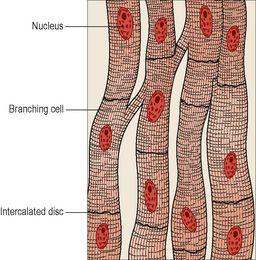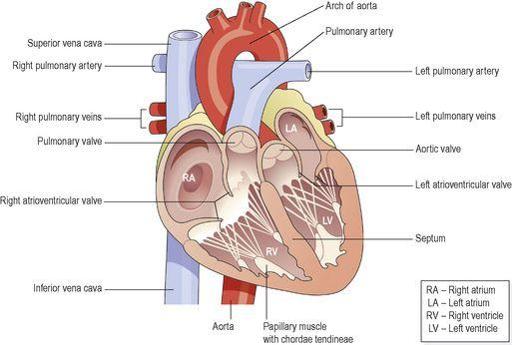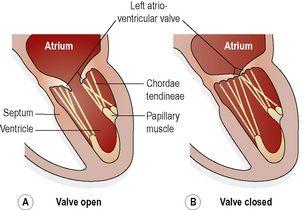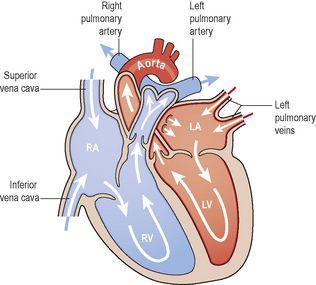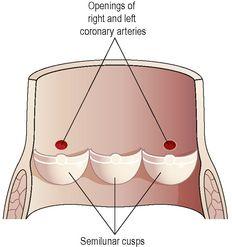Ross & Wilson Anatomy and Physiology in Health and Illness (39 page)
Read Ross & Wilson Anatomy and Physiology in Health and Illness Online
Authors: Anne Waugh,Allison Grant
Tags: #Medical, #Nursing, #General, #Anatomy

The serous membrane consists of flattened epithelial cells. It secretes serous fluid into the space between the visceral and parietal layers, which allows smooth movement between them when the heart beats. The space between the parietal and visceral pericardium is only a
potential space
. In health the two layers lie closely together, with only the thin film of serous fluid between them.
Myocardium
The myocardium is composed of specialised cardiac muscle found only in the heart (
Fig. 5.12
). It is not under voluntary control but is striated, like skeletal muscle. Each fibre (cell) has a nucleus and one or more branches. The ends of the cells and their branches are in very close contact with the ends and branches of adjacent cells. Microscopically these ‘joints’, or
intercalated discs
, are thicker, darker lines than the striations. This arrangement gives cardiac muscle the appearance of being a sheet of muscle rather than a very large number of individual cells. Because of the end-to-end continuity of the fibres, each one does not need to have a separate nerve supply. When an impulse is initiated it spreads from cell to cell via the branches and intercalated discs over the whole ‘sheet’ of muscle, causing contraction. The ‘sheet’ arrangement of the myocardium enables the atria and ventricles to contract in a coordinated and efficient manner.
Figure 5.12
Cardiac muscle fibres.
Running through the myocardium is also the network of specialised conducting fibres responsible for transmitting the heart’s electrical signals. The myocardium is thickest at the apex and thins out towards the base (
Fig. 5.13
). This reflects the amount of work each chamber contributes to the pumping of blood. It is thickest in the left ventricle, which has the greatest workload.
Figure 5.13
Interior of the heart.
Fibrous tissue in the heart
The myocardium is supported by a network of fine fibres that run through all the heart muscle. This is called the
fibrous skeleton
of the heart. In addition, the atria and the ventricles are separated by a ring of fibrous tissue, which does not conduct electrical impulses. Consequently, when a wave of electrical activity passes over the atrial muscle, it can only spread to the ventricles through the conducting system that bridges the fibrous ring from atria to ventricles (
p. 83
).
Endocardium
This lines the chambers and valves of the heart. It is a thin, smooth, glistening membrane that permits smooth flow of blood inside the heart. It consists of flattened epithelial cells, and it is continuous with the endothelium lining the blood vessels.
Interior of the heart
The heart is divided into a right and left side by the
septum
(
Fig. 5.13
), a partition consisting of myocardium covered by endocardium. After birth, blood cannot cross the septum from one side to the other. Each side is divided by an
atrioventricular valve
into the upper atrium and the ventricle below. The atrioventricular valves are formed by double folds of endocardium strengthened by a little fibrous tissue. The
right atrioventricular valve
(tricuspid valve) has three flaps or cusps and the left atrioventricular valve (mitral valve) has two cusps. Flow of blood in the heart is one way; blood enters the heart via the atria and passes into the ventricles below.
The valves between the atria and ventricles open and close passively according to changes in pressure in the chambers. They open when the pressure in the atria is greater than that in the ventricles. During
ventricular systole
(contraction) the pressure in the ventricles rises above that in the atria and the valves snap shut, preventing backward flow of blood. The valves are prevented from opening upwards into the atria by tendinous cords, called
chordae tendineae
, which extend from the inferior surface of the cusps to little projections of myocardium into the ventricles, covered with endothelium, called
papillary muscles
(
Fig. 5.14
).
Figure 5.14
The left atrioventricular valve: A.
Valve open.
B.
Valve closed.
Flow of blood through the heart (
Fig. 5.15
)
The two largest veins of the body, the
superior
and
inferior venae cavae
, empty their contents into the right atrium. This blood passes via the right atrioventricular valve into the right ventricle, and from there is pumped into the
pulmonary artery
or
trunk
(the only artery in the body which carries deoxygenated blood). The opening of the pulmonary artery is guarded by the
pulmonary valve
, formed by three
semilunar cusps
. This valve prevents the backflow of blood into the right ventricle when the ventricular muscle relaxes. After leaving the heart the pulmonary artery divides into
left
and
right pulmonary arteries
, which carry the venous blood to the lungs where exchange of gases takes place: carbon dioxide is excreted and oxygen is absorbed.
Figure 5.15
Direction of blood flow through the heart.
Two
pulmonary veins
from each lung carry
oxygenated blood
back to the
left atrium
. Blood then passes through the left atrioventricular valve into the left ventricle, and from there it is pumped into the aorta, the first artery of the general circulation. The opening of the aorta is guarded by the
aortic valve
, formed by three
semilunar cusps
(
Fig. 5.16
).
Figure 5.16
The aorta cut open to show the semilunar cusps of the aortic valve.
From this sequence of events it can be seen that the blood passes from the right to the left side of the heart via the lungs, or pulmonary circulation (
Fig. 5.17
). However, it should be noted that both atria contract at the same time and this is followed by the simultaneous contraction of both ventricles.
